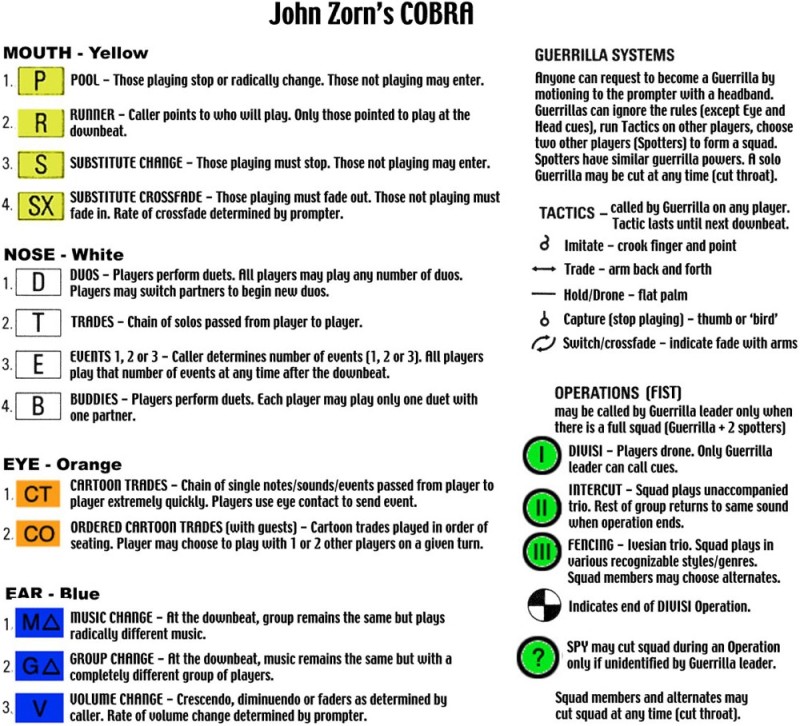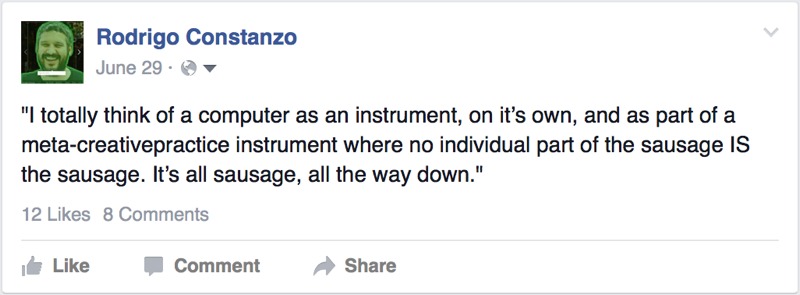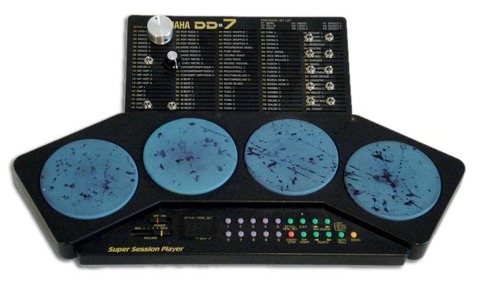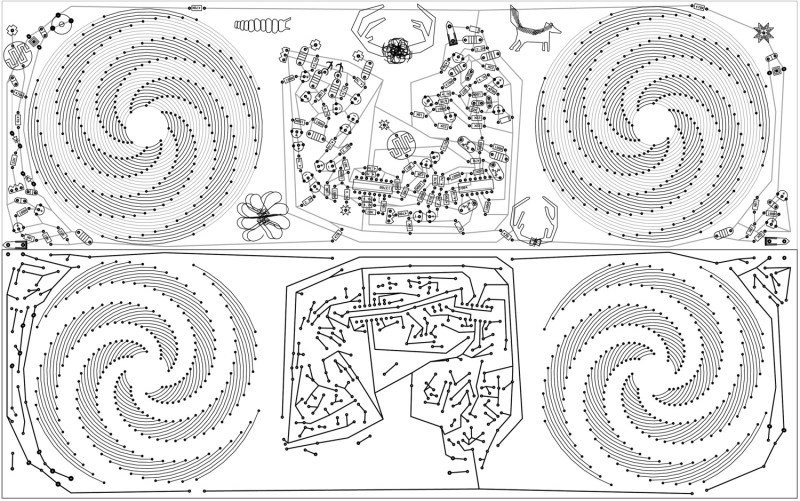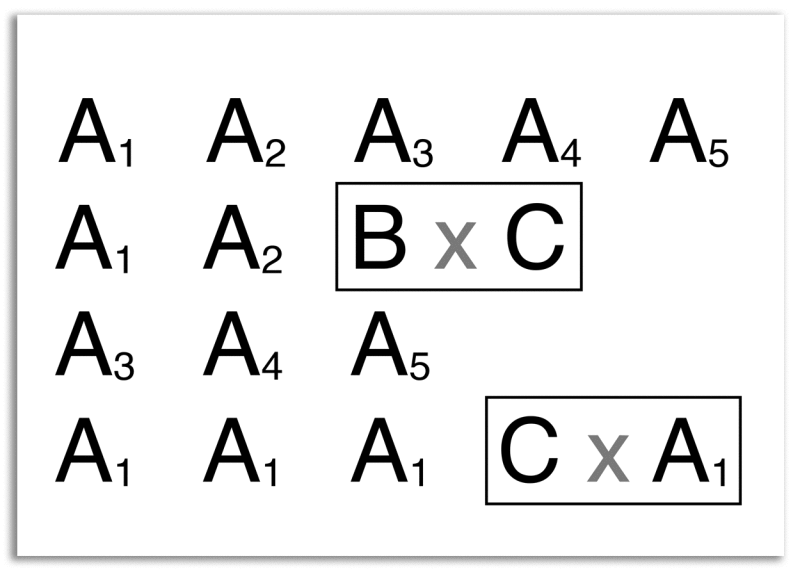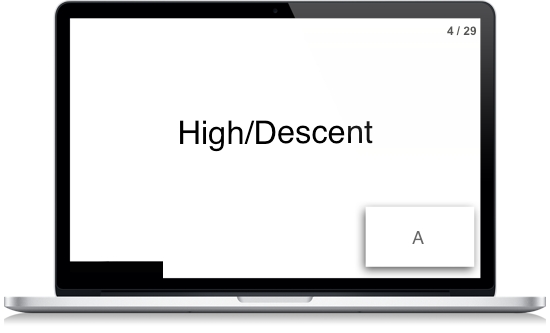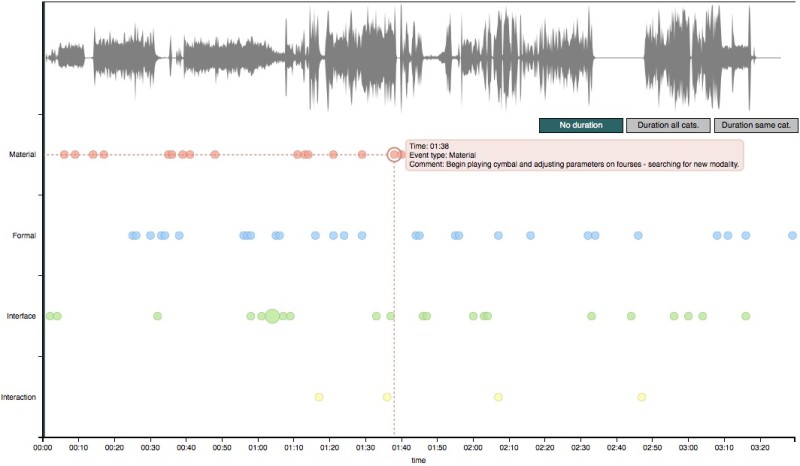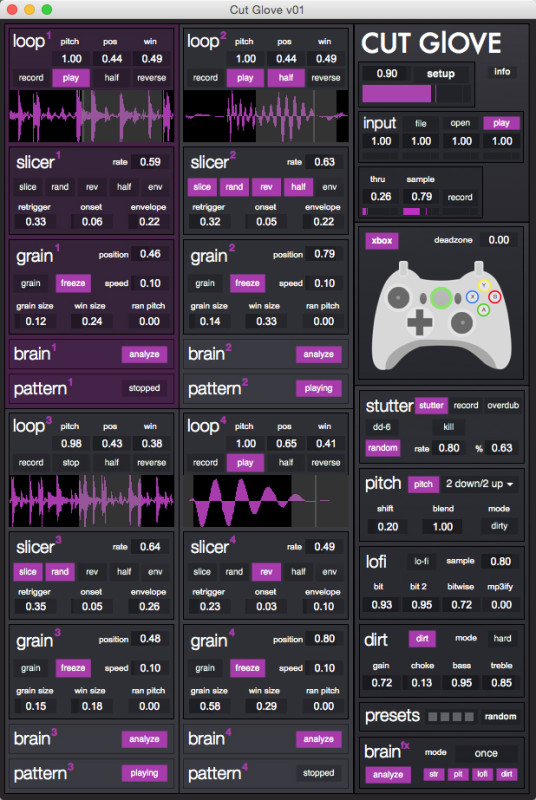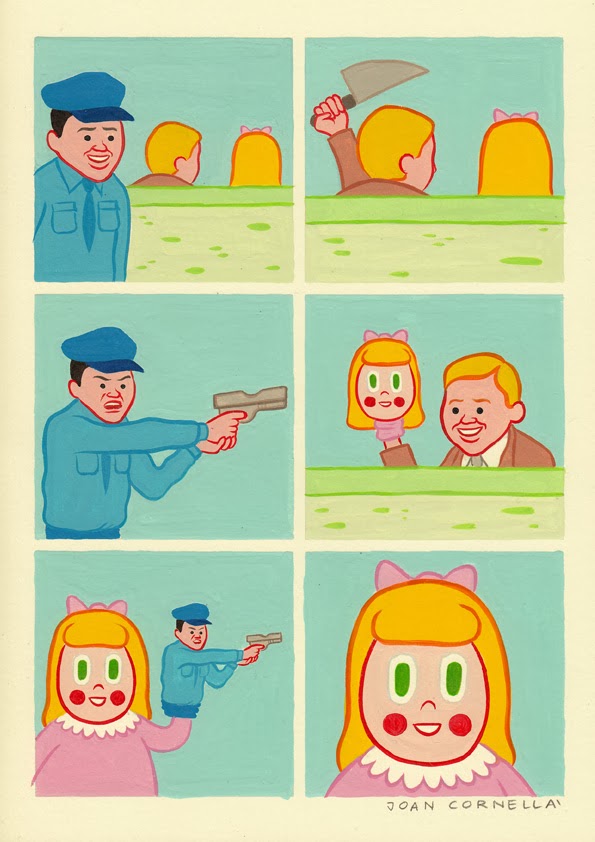
When I was younger I used to reach into the shower and turn the hot and cold faucets randomly, and then force myself to take a shower at that temperature. After doing this for a while I incorporated the rule that if the water was dangerously hot or freezing cold I would randomize the faucets again. Shortly after introducing this safety net I stopped taking showers in this way. It didn’t mean anything anymore.
///////////////////////////////////////////////////////////////////////////////////////////////////////////////////////////////////////////////////////////////////////
Table of Contents
The End
All of the Things
The Eyes (and “Non-Performance”)
The Body
The Heart (of)
The Beginning
///////////////////////////////////////////////////////////////////////////////////////////////////////////////////////////////////////////////////////////////////////
The End
, which sees no beginning or end, is presented [frozen, sanitized, flattened] as a snapshot here. The work is made up of a network of compositions, videos, recordings, software, scores, performances, and improvisations which all interrelate and feed into each other. Each individual component rarely stands alone, or has clear temporal boundaries.
The following diagram shows the submitted compositions, software, and other selected projects, and some of how they relate conceptually, temporally, technologically, and aesthetically. You can interact with the diagram by selecting the different views, hovering over individual nodes (to see type, description, and links), and connections (to see how/why things are connected).
///////////////////////////////////////////////////////////////////////////////////////////////////////////////////////////////////////////////////////////////////////
All of the Things
Collapsing of Roles
At the center of this network/loop/web lies an integrated practice. My practice is centered around composing for myself, as an improviser, often using instruments, both software and hardware based, that I have made myself. Collapsing the generally detatched creative process into a singular continuum where there are no roles, or discrete steps, allows me to move more freely in the grey areas between where the roles would generally fall (Jensenius 2012): an un-quantized creative space.

Traditional chain in the musical ecosphere. From Alexander Refsum Jensenius.
This is of particular significance as it informs my general approach to composition. In improvisation, John Cage‘s classic “trinity” of composer, performer, and listener are one and the same (Cox and Warner 2004). More to the point, composition and performance occupy the same temporal space. Or, as Steve Lacy responded to Frederic Rzewski‘s request to describe, in fifteen seconds, the difference between composition and improvisation:
In fifteen seconds the difference between composition and improvisation is that in composition you have all the time you want to decide what to say in fifteen seconds, while in improvisation you have fifteen seconds (Bailey 1993).
When these individual roles no longer exist, the creative process takes on a different shape, which is intrinsically less output-driven. I view teaching, sharing, programming, and engaging with communities as being as valuable as composing, performing, and making videos. It is more about the verb than the noun. It is musicking, to borrow the term from Christopher Small (Small 1998), something inherently non-role-based.
The traditional model of composer to performer as a top-down communication, where the composer—traditionally the originator of ideas—is required to symbolically reinterpret those ideas (via notation and language) to yield a sonic output, utilizing the performer as his medium, as described by Jean-Jacques Nattiez in this book, collapses when all the roles are taken on by one person. In addition to smearing the creative touch across time (composition->performance) and apparatus (code->construction), the removal of a layer of “interpretation” precludes the charging of a performance with an overabundance of interpretive expression “even when none exists”, as critiqued by Roger Heaton here.
The Now (or “Improvisation”)
All of the material presented here contains improvisation in some form or another. Improvisation itself is, in this way, central to my practice. It is present at all stages of the creative continuum, from decisions made about instrument and software design, to the real-time performance of music. I believe that when you are completely fluid and comfortable with your improvisation, and “plac[e] yourself into the extraordinary energy of the moment”, you can create things beyond your knowledge and, occasionally, ability (Ninh 2010). Karlheinz Stockhausen calls this being a “radio receiver” where “you are no longer satisfied with expressing yourself, you are not interested in yourself at all . . . [y]ou become a medium” (Stockhausen and Maconie 1989). Although Stockhausen is not known for his thoughts on improvisation, I find the idea of intuitional or improvisational transcendence to be a powerful one.
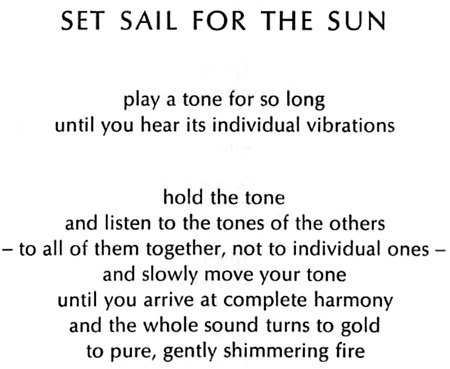
from Aus Den Sieben Tagen by Karlheinz Stockhausen
This is in opposition to Cage‘s view that “improvisation is something that [he] want[s] to avoid. Most people who improvise slip back into their likes and dislikes, and their memory, and they don’t arrive at any revelation that they’re unaware of” (Turner 1992). Pierre Boulez, along with Cage, was critical of improvisers’ capacities to step outside of themselves, stating that improvisers need a “primary form of material” that exists outside of themselves (Boulez 1986). I disagree with this sentiment put forward by both Cage and Boulez, and see their concerns as speaking more about their (limited) understanding of what it truly means to improvise than an inherent constraint of the practice itself.
John Zorn‘s curatorial approach to improvisation, specifically in his game piece Cobra, resonates strongly with me. Cobra consists of a series of systems which can be called into effect by any performer, at any time, with a single conductor acting as the information conduit by holding up cue cards with symbols representing each system. What I find most exciting about Cobra, as a composer, performer, and conductor, is that Zorn does not prescribe any musical material in the piece. The content of each system is a type of interaction or behavior, which the performers are free to populate with whatever material they like. This approach is something that is used heavily in several of my compositions.
In addition to the relationship and behavior-centric approach of Zorn’s game pieces, some of the music of Christian Wolff embodies what I find interesting in improvisation. The way Wolff uses relational concepts and notation, where performers are dependent on each other for cues/prompts, is fascinating to me, as a composer, performer, and listener. The sense of immediacy and danger comes through in the performance and evokes an improvisational ephemerality.
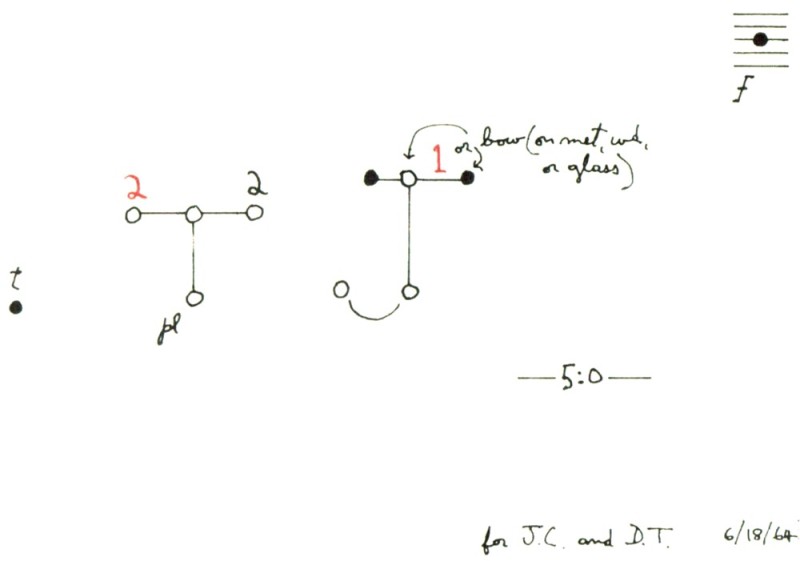
from For 1, 2 or 3 People by Christian Wolff
Underpinning my approach to improvisation is a political subtext in which I attempt to collapse the composer/performer hierarchy. Improvisation is an inherently democratic process, as each performer has a say on the direction that a given performance will go. This democratic concern is partly responsible for my shift towards behavior/relationship-centric compositions where little to no musical material is prescribed. These kinds of compositions allow for what Anthony Braxton describes as “the possibility of defining the space in a way where it can be evolutionary”(Lock 1989). Having a strict compositional bounding would limit the scope of this “evolution”.

graphic score from Anthony Braxton
O.P.P. & Multi-instrumentality
As a performer (of other people’s pieces (O.P.P.)) I trained as a classical pianist from an early age, later moving on to guitar (classical, rock, jazz), and finally to playing primarily drums/percussion now. I played most of these instruments professionally for many years and still view music through the filter of instrumentality. Being an instrumentalist, in the broadest sense of the word, is part of my identity as a creative person, regardless of what I aspect of creativity I am engaged with at the time.
This identity was challenged during a moment of enhanced lucidity when I realized I no longer identified as a pianist or a guitarist, the two instruments I had spent the majority of my life learning/rehearsing/performing. The music I was making, and wanted to make, did not fit with these period instruments of “lattice-based music”, as Trevor Wishart puts it in this book. Even though I still identified myself as an instrumentalist, and saw the creation of music as having strong associations with performance, I felt the need pull away from the instruments with which I had developed a high level of facility.
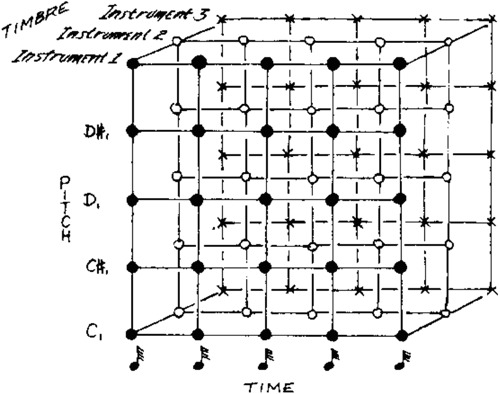
Music on a three-dimensional lattice. From On Sonic Art by Trevor Wishart (26).
This multi-instrumentality later found a home in a new music ensemble (Distractfold Ensemble) in which I was a performer from 2013 to 2015. During my time in the group I performed on percussion, objects, guitar, voice, and electronics. One of our highlights while I was with the group was winning the Kranichstein Music Prize at the 47th Internationales Musikinstitut Darmstadt. This chamber-centric performing allowed me to hone my general instrumental, interpretive, and musicianship skills, something that would come in handy in my own integrated practice.
I found that through developing a multi-instrumental performance practice, I was building up a mental, as well as physical, dexterity that could be easily reapplied and redirected. Learning new instruments or performance techniques would come quickly, as it was more a matter of rewiring/repatching existing skills and abilities rather than developing new ones. This is similar to Pierre Alexandre Tremblay‘s recycled virtuosity described in this paper on his Sandbox#3 performance setup.
Instrumental dexterity and virtuosity take on completely different meanings when building and performing on DIY/invented instruments which have little to no context/canon to draw on. This issue is manageable when dealing with instruments that are somewhat similar to existing instruments (Specty, Electric Whisks, Sidrassi-Tom), although their hybrid nature creates both physically and mentally complex interactions. But it certainly becomes complicated when dealing with simpler (digital) instruments driven by concept, software, or systematic interaction. The code underlying these instruments can “be seen as the wood and strings of the digital instrument maker” (Magnusson 2010). How does one become a virtuoso of an instrument made out of only two knobs? There is nothing unusual about the physical dexterity involved in performing with such an instrument, so what then makes one a virtuoso at it? And if it is not a physical dexterity, where does that virtuosity reside?
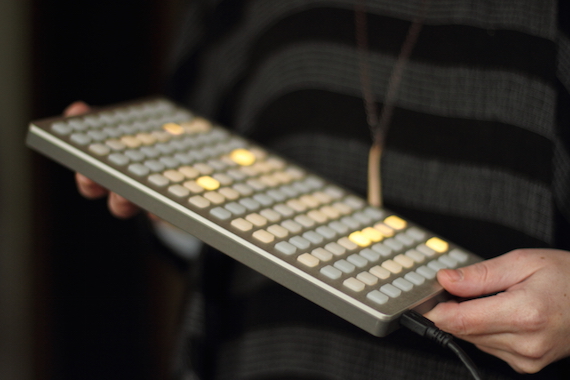
Vertical/conceptual integration of software/hardware/tool/instrument design. from monome.org
A mental/conceptual/non-physical dexterity, or instrumentality, as a re-assignable attribute has permeated much of my practice. It has not only informed how I compose and perform music, but also how I approach building software/hardware instruments. Thor Magnusson describes this kind of virtuosity being “not at the level of the instrument itself . . . but rather below the instrument at the strata of hardware and code” in this paper. The integrated-practice-ness of this can be seen in other creators, such as Brian Crabtree‘s (tehn‘s) performances with monome controllers where the virtuosity on display comes not from the physical movements during performance, but from the vertical/conceptual integration of software/hardware/tool/instrument design. As a performer, the nuanced touch that we normally associate with virtuosity is exhibited in a different manner. The touch is all over the thing, not just where the finger meets the string.
D.I.(Y/Why?)
My interest in DIY instruments stems from electronic tinkering when I was younger. I began by trying to make my own guitar pedals, and then moved onto circuit-bending, and later hardware synth making. Sound became something that I literally made with my hands, and instruments were no longer “black boxes” that were simply played by touching their surfaces. Much like with Cage‘s prepared piano, sticking metal bits into the guts of the instruments became part of the creative process.
One of my main interests in making my own hardware instruments was that I could create not only unique sounds and playing methods, but each instrument could imply its own language and syntax, much like how the length of the bow and an exhaling of breath implies a phrasing grammar in bowed/blown instruments. Laurie Spiegel puts this eloquently when discussing the budding era of computer music/instruments: “Creative arts require tools designed with awareness that the primary need of most users is to be able to create completely unique works in completely personal ways” (Spiegel 1996). I could not agree more with this.
Unlike the Baschet brothers who created visually stunning and novel instruments to primarily model them on existing instruments and performance techniques, my main interest was to use DIY instruments to craft a new music (Baschet 1999). I share Bart Hopkin‘s disappointment that “most musical instruments are not intended to explore those possibilities anew; they are modeled after preexisting types” from his great book. My interest and approach with hardware instruments is closer to Harry Partch‘s, in that he created his own instruments as a means to an end, with the end being his own personal music (Partch 1974).
There is an element of unpredictability and randomness involved in most of the DIY instruments I make. Circuit-bending in particular is effective for creating unpredictable frequencies and random musical fragments which “can be truly fascinating as generated by the out-of-theory electronic instrument” (Ghazala 2006). Incorporating randomness, through electronic intervention, into a composed/improvised context is both very powerful and challenging, serving as a technological dowsing rod pointing towards the unknown.
I have built and performed with many of Peter Blasser‘s instruments over the years and find many aspects of his work inspiring and fascinating. How he designs random timing capacitors and resistors into his circuits, specifically in older kits and paper circuits, makes building the instrument an extension of performing with it since “[e]ach iteration of a paper circuit is unique, because the time elements vary with the change of component values in key locations” (Blasser 2007). Designing and building instruments in this way collapses many creative roles in an interesting way, fitting in with my views on integrated practice.
Although most of my DIY instruments are hardware-based I do not share John Richards‘ “digital allergy”, where the creation of new instruments is part of an effort to “dislodge the ubiquity of digital technology”, viewing analog, or “dirty” electronics, in opposition to “the sterile world of mass-produced digital technology” as put by Richards in this article. I draw no distinction between analog, digital, or even acoustic instruments. Technology, in any incarnation, is simply a tool that one can use to articulate creative ideas.
Writing It Down
Notation is taking an ever decreasing role in my music. As much as I enjoy the look of a beautiful or clever score, I have lost interest in the fetish object which is an aesthetically pleasing score which is disconnected from its informative functionality. As such, notation occupies very little of my compositional time and concerns. I share Partch‘s view that:
[N]otation is the least of a music’s ingredients, one that might be supplied on little more than a moment’s notice. To provide a notation is a matter of paper and pencil and a good night’s sleep; but to evolve a theory, to develop instruments based upon it, and to write and present music conceived therefrom is easily the matter of a lifetime (Partch 1974).
Towards the beginning of my thesis, and just before, I was composing instrumental and mixed music that still heavily relied on legacy notation. This was largely to do with my background and upbringing as a performer and composer of classical music. Music was something that was written down. Even with these pieces, notation began to fail as soon as I would incorporate electronics or DIY instruments. (Traditional) notation failed when trying to notate for unpredictable and/or chaotic instruments.
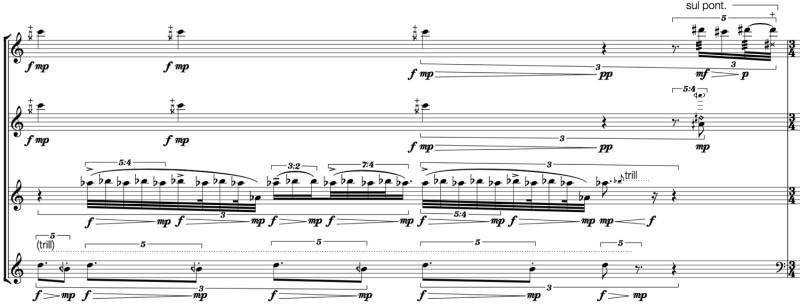
from It’s Made From Pieces Of From Pieces Of My Skin – for string quartet and four computer hard drives
This trajectory eventually led me to question the role of notation, and composition, in my work altogether, something that I outline in detail in the commentary for iminlovewithanothergirl.com, the second piece written during my PhD thesis. During the “compositional process” of iminlovewithanothergirl.com I questioned everything about my creative practice, mainly because this was the first piece in which I dealt with the ramifications of a collapsed creative continuum. How do I compose and notate something for myself, as a performer, who will be improvising, using an instrument that is unpredictable and difficult to control? In the end I arrived at a solution using form as the prime compositional material, and came up with a simplified notation to communicate that with.
After composing iminlovewithanothergirl.com I began working on ialreadyforgotyourpussy.com, a piece built on some of the concepts and approaches used in iminlovewithanothergirl.com, but with a focus on memory. The piece was composed for Richard Craig (on amplified flute) and me (on amplified snare), and was originally communicated to Richard via aural instructions. As such, notation was completely absent for much of the compositional and rehearsal process of ialreadyforgotyourpussy.com.
Eventually I realized that I needed something that would decouple the performers’ ability to make decisions about what to log and recall from memory. Technology, I decided, should mediate intervention, leading to ialreadyforgotyourpussy.com becoming the first piece to use the, then recently developed, dfscore system, a realtime dynamic score system discussed in detail here. This shift reincorporated notation into my practice, but in a completely different manner. It was no longer fixed written material on paper; it was now dynamic, restructurable material flowing across ethernet cables and onto laptops/iPads.
Aesthetic Domain/Awareness
A large part of my creative practice involves a meta-creativity: a redirecting of creative focus as part of the creative act itself. These focal points [form, memory, interaction, synchronicity, instrumentation, analysis, metaphor] are subsets of my aesthetic domain, something formed by the totality of my life (as it relates to art). How and where we focus this creative energy, as well as how/where/why we live our lives, is a fundamental, yet often overlooked, aspect of the creative practice.
I described this idea in a personal email to my mom, a professional photographer, after a trip we took together to a nature retreat to take photos of birds, as follows:
i was thinking on the first day, as we were all waiting to get on the all-day boat that everyone, is going to the same place, roughly with the same gear, and that the only thing that separates the art that will come of that experience is the singular experience of being the human being that has lived their life up to that point. that the way one lives one’s life acts as the prism through which we transform the world around us into art.
In a way, this idea is very similar to how Glenn Gould describes a future in which art and life become intertwined as “the best of all possible worlds”, stating that “[t]he audience would be the artist and their life would be art” (Gould and Page 1984).
Central to this aesthetic collapsing and meta-creativity is an emphasis on divergent thinking, something that is central to the idea of creativity itself (Guilford 1950). This “restructuralism”, as Anthony Braxton would describe it, happens when “the structural properties or the whole mentality . . . undergoes a change” (Lock 1989). This kind of critical divergence is commonplace among all the art/music that I find interesting/challenging, and at a fundamental level deeply informs my creative decisions and interests.
Over the last couple of years I have performed (my own music) live less and less and have made more and more videos. This was not a specifically conscious choice, but a tendency that I only noticed after the fact. Performing in front of a camera, as a virtual audience, scratched the same itch as performing live. For me, as a performer, it is imbued with the same ritual sense of time and space as performing in front of people. It has also allowed for some profound collaborations with Angela Guyton (and others). When video becomes more than a document, and its own medium, there are things that you can do that cannot happen in a live context. It is not a film, nor it is performance. It is something different.
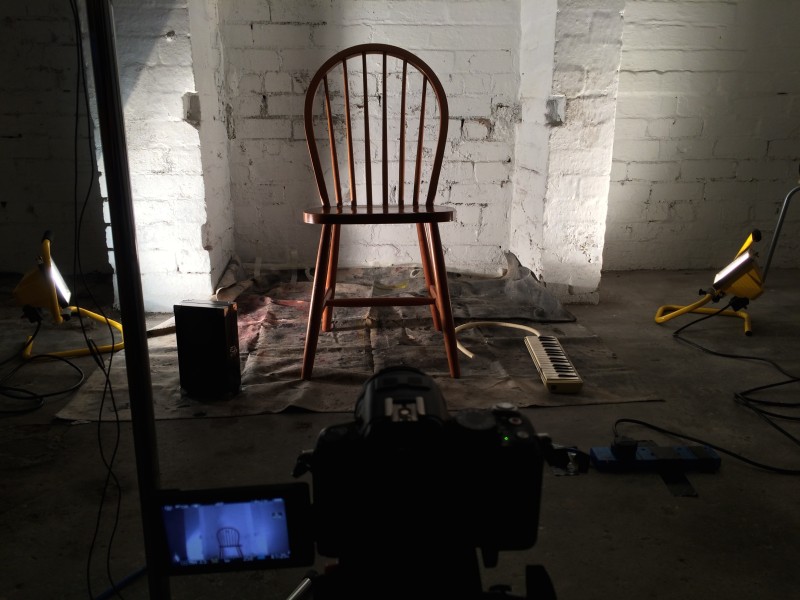
from the filming of Everything. Everything at once. Once. (3)
When I do perform live I prefer performing at informal “gigs”, where a variety of music is performed, generally by the people who composed it. I find that setting to be the “adequate mode of listening” for my music/art, to borrow a term from Ola Stockfelt (Schwarz 1997). This is in contrast to more formal “concert” settings, which I find to be socio-politically charged, in a McLuhan-esque manner, with the medium/container of “concert”-ness, and its unidirectional nature, carrying more weight than the music itself (McLuhan 1964). Furthermore, the programmatic nature of many concerts, which “accept at the outset the basic premises that unite the audience”, through a curated theme or prompt, reduces the potential experience by “put[ting] on the audience, repeating clichés familiar to it” (Carpenter 1970). Mathemusician Vi Hart explains this idea poetically in this video about Edmund Snow Carpenter‘s book They became what they beheld.
///////////////////////////////////////////////////////////////////////////////////////////////////////////////////////////////////////////////////////////////////////
The Eyes (and “Non-Performance”)
///////////////////////////////////////////////////////////////////////////////////////////////////////////////////////////////////////////////////////////////////////
The Body
“And how can we expect anyone to listen if we are using the same old voice? We need new noise.”
— Refused
This section contains the media and commentaries for all the submitted pieces and projects which can be browsed via their conceptual, temporal, technological, and aesthetic relationships.
///////////////////////////////////////////////////////////////////////////////////////////////////////////////////////////////////////////////////////////////////////
The Heart (of)
Over the last couple of years I have written an increasing amount of blog posts getting into the details about the hows and whys of what I do. It seemed only fitting that the central body of this thesis would be presented in the same manner. The two blog posts which form the central body of this thesis are presented here because of how technology and aesthetics are intertwined within them. This is a single circuit in the complex nest of feedback loops made manifest. They can be read in any order, as each was written to be a standalone blog post, functioning even outside of the context of this thesis.
Technology, and specifically how it relates to aesthetics, is a big part of what I spend my time and energy on. A common thread through nearly all of the projects presented here is their use of technology, be it through DIY instruments, modified electronics, or software systems. These technological developments are intertwined with the work they produce. Similarly, aesthetic considerations, and how they relate to technology, form a second parallel strand in my work. As such, technology and aesthetics form an undercurrent flowing through the whole thesis, but come to the surface for the two central chapters.
Making decisions in time (technically driven aesthetic developments) is a conceptual framework and analysis tool for improvisation which focuses on separating decisions into Material, Formal, Interface, and Interaction streams. In this way it is both an aid for thinking about improvisation in a general sense, as well as a manner in which to reflect on and improve one’s own improvisational practice. The dedicated chapter on this framework covers the conception, background, development, and future plans for the system, including several in-depth analyses made with the system.
Cut Glove (aesthetically driven technical developments) is a software system/instrument built around video game mechanisms and metaphors, using an Xbox 360 controller. The chapter explores virtuosity, particularly with regard to performance using electronic instruments, and how this relates to video game design, techniques, and culture. The chapter details the background, development, and implementation of the software built in Max, and includes contextualization and critical observations of video games as applied to music and design.
The dichotomies between these ideas, the reflective introspection and conceptual focus of Making decisions in time in relation to the performative considerations and technical focus of Cut Glove, were central to their developments. Yet, I don’t know if either project would have happened or developed on its own, at least to the level that they have, without the contrast of the other bubbling away conceptually/technically/aesthetically in the background (sideground?). Their central foci, although seemingly opposed, created an intertwined development process where the aesthetic considerations of one project would inform the technical developments in the other, and vice versa.
These two projects, Making decisions in time and Cut Glove, are here presented as examples of a feedback process and intertwinement. The two blog posts form a central binary case study of this thesis that explores how technology and aesthetics inform each other within my creative work.
///////////////////////////////////////////////////////////////////////////////////////////////////////////////////////////////////////////////////////////////////////
The Beginning
The work presented here in this thesis loops in on itself as a meta-creative process, and shifts its focus from concepts like form and memory to processes like programming and video editing. The very act of redefining and redirecting the creative process, and its scope, forms an integral consideration for the creative act.
The twin chapters on aesthetically driven technological concerns and technologically driven aesthetic concerns, which form the body of thesis, delineate separations in the process. Even the very act of encircling these areas for comparison begs for the dissolving of those boundaries and to build others up anew. Everything is material to engage with creatively: construct, reprogram, hack, record, replay, film, edit: a process which collapses the separation between all of the facets of my creative work.











